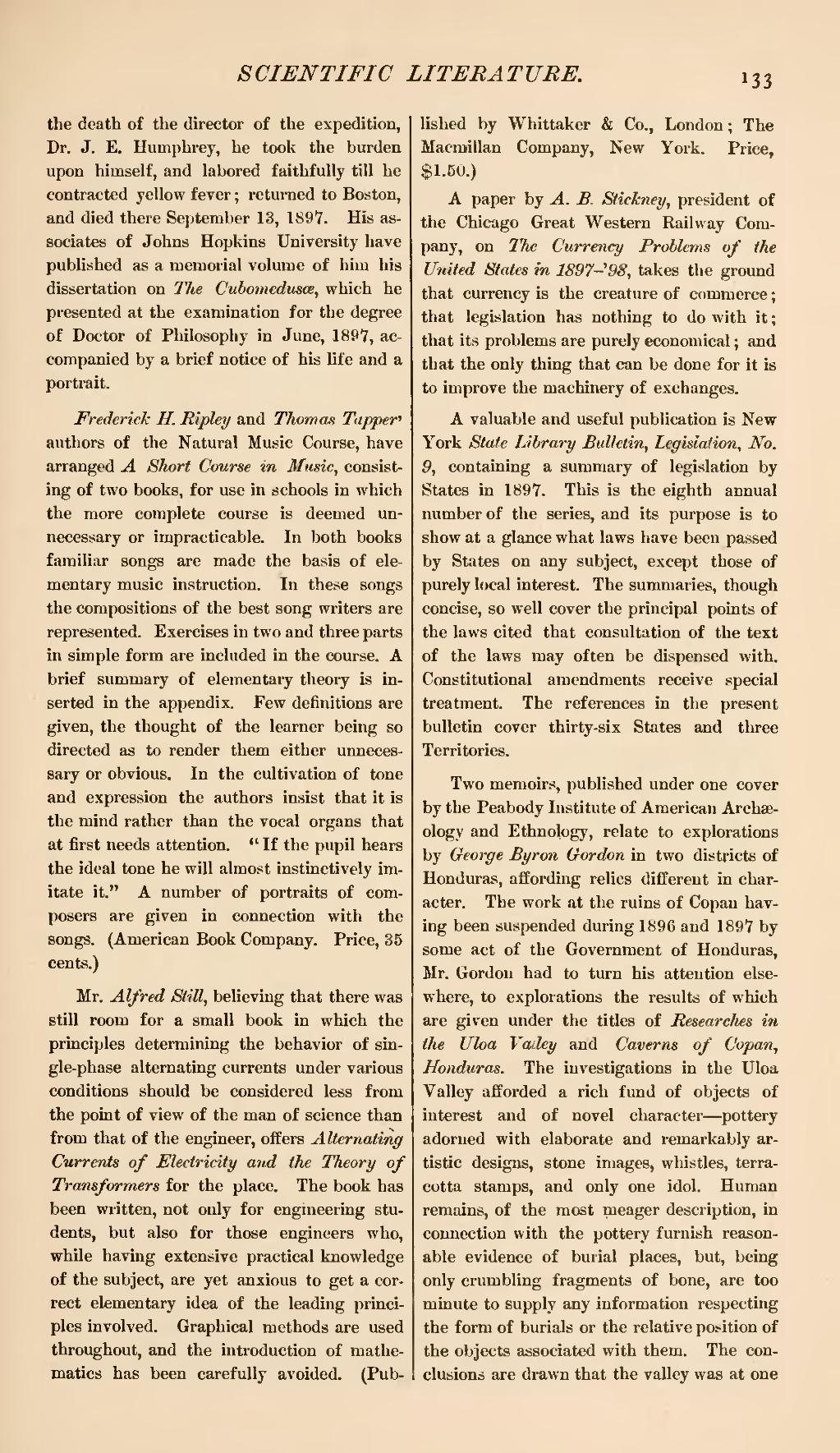the death of the director of the expedition, Dr. J. E. Humphrey, he took the burden upon himself, and labored faithfully till he contracted yellow fever; returned to Boston, and died there September 13, 1897. His associates of Johns Hopkins University have published as a memorial volume of him his dissertation on The Cubomedusæ, which he presented at the examination for the degree of Doctor of Philosophy in June, 189*7, accompanied by a brief notice of his life and a portrait.
Frederick H. Ripley and Thomas Tapper' authors of the Natural Music Course, have arranged A Short Course in Music, consisting of two books, for use in schools in which the more complete course is deemed unnecessary or impracticable. In both books familiar songs are made the basis of elementary music instruction. In these songs the compositions of the best song writers are represented. Exercises in two and three parts in simple form are included in the course. A brief summary of elementary theory is inserted in the appendix. Few definitions are given, the thought of the learner being so directed as to render them either unnecessary or obvious. In the cultivation of tone and expression the authors insist that it is the mind rather than the vocal organs that at first needs attention. "If the pupil hears the ideal tone he will almost instinctively imitate it." A number of portraits of composers are given in connection with the songs. (American Book Company. Price, 35 cents.)
Mr. Alfred Still, believing that there was still room for a small book in which the principles determining the behavior of single-phase alternating currents under various conditions should be considered less from the point of view of the man of science than from that of the engineer, offers Alternating Currents of Electricity and the Theory of Transformers for the place. The book has been written, not only for engineering students, but also for those engineers who, while having extensive practical knowledge of the subject, are yet anxious to get a correct elementary idea of the leading principles involved. Graphical methods are used throughout, and the introduction of mathematics has been carefully avoided. (Published by Whittaker & Co., London; The Macmillan Company, New York. Price, $1.50.)
A paper by A. B. Stickney, president of the Chicago Great Western Railway Company, on The Currency Problems of the United States in 1897-'98, takes the ground that currency is the creature of commerce; that legislation has nothing to do with it; that its problems are purely economical; and that the only thing that can be done for it is to improve the machinery of exchanges.
A valuable and useful publication is New York State Library Bulletin, Legislation, No. 9, containing a summary of legislation by States in 1897. This is the eighth annual number of the series, and its purpose is to show at a glance what laws have been passed by States on any subject, except those of purely local interest. The summaries, though concise, so well cover the principal points of the laws cited that consultation of the text of the laws may often be dispensed with. Constitutional amendments receive special treatment. The references in the present bulletin cover thirty-six States and three Territories.
Two memoirs, published under one cover by the Peabody Institute of American Archæology and Ethnology, relate to explorations by George Byron Gordon in two districts of Honduras, affording relics different in character. The work at the ruins of Copan having been suspended during 1896 and 1897 by some act of the Government of Honduras, Mr. Gordon had to turn his attention elsewhere, to explorations the results of which are given under the titles of Researches in the Uloa Valley and Caverns of Copan, Honduras. The investigations in the Uloa Valley afforded a rich fund of objects of interest and of novel character—pottery adorned with elaborate and remarkably artistic designs, stone images, whistles, terracotta stamps, and only one idol. Human remains, of the most meager description, in connection with the pottery furnish reasonable evidence of burial places, but, being only crumbling fragments of bone, are too minute to supply any information respecting the form of burials or the relative position of the objects associated with them. The conclusions are drawn that the valley was at one

